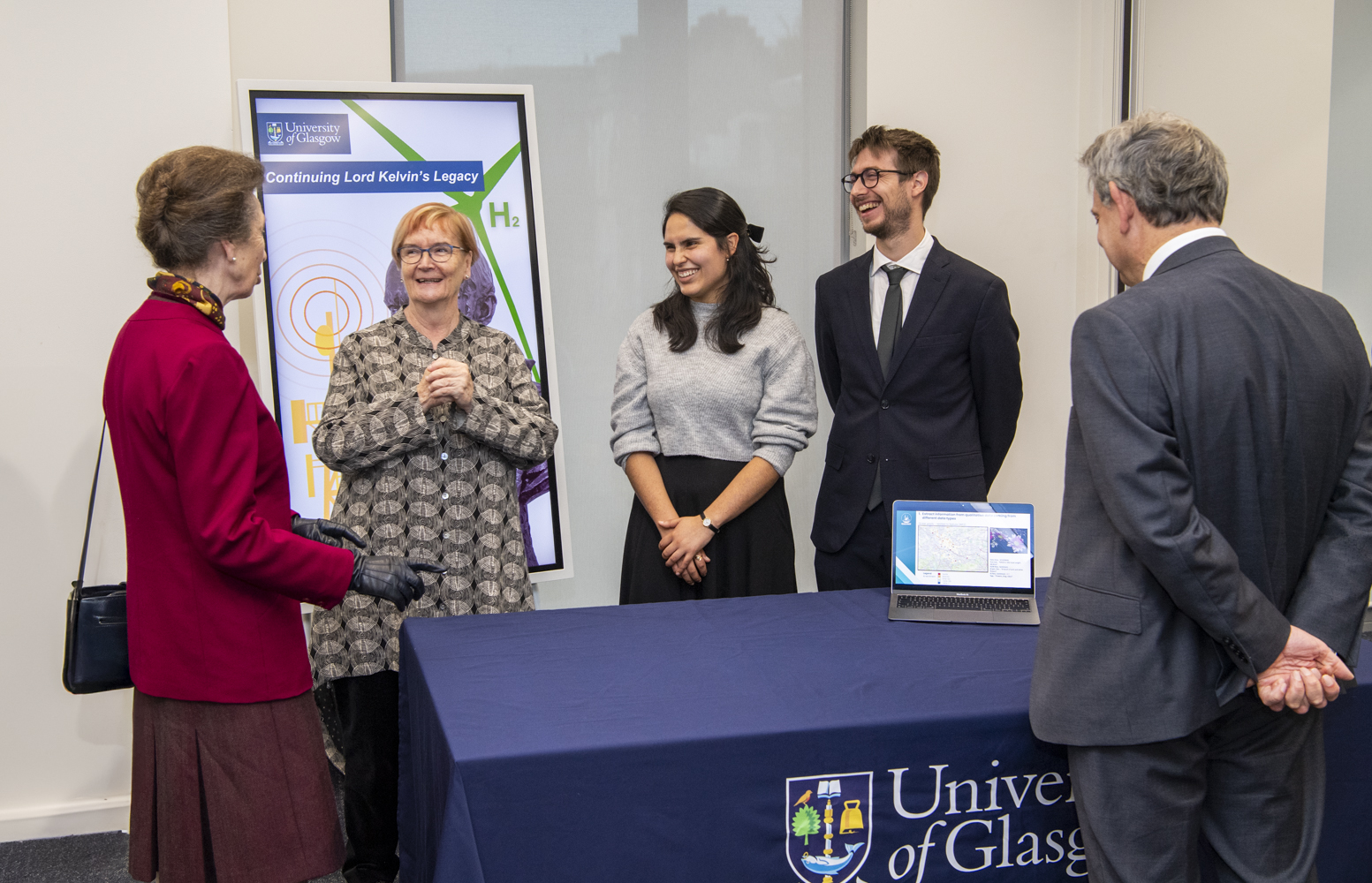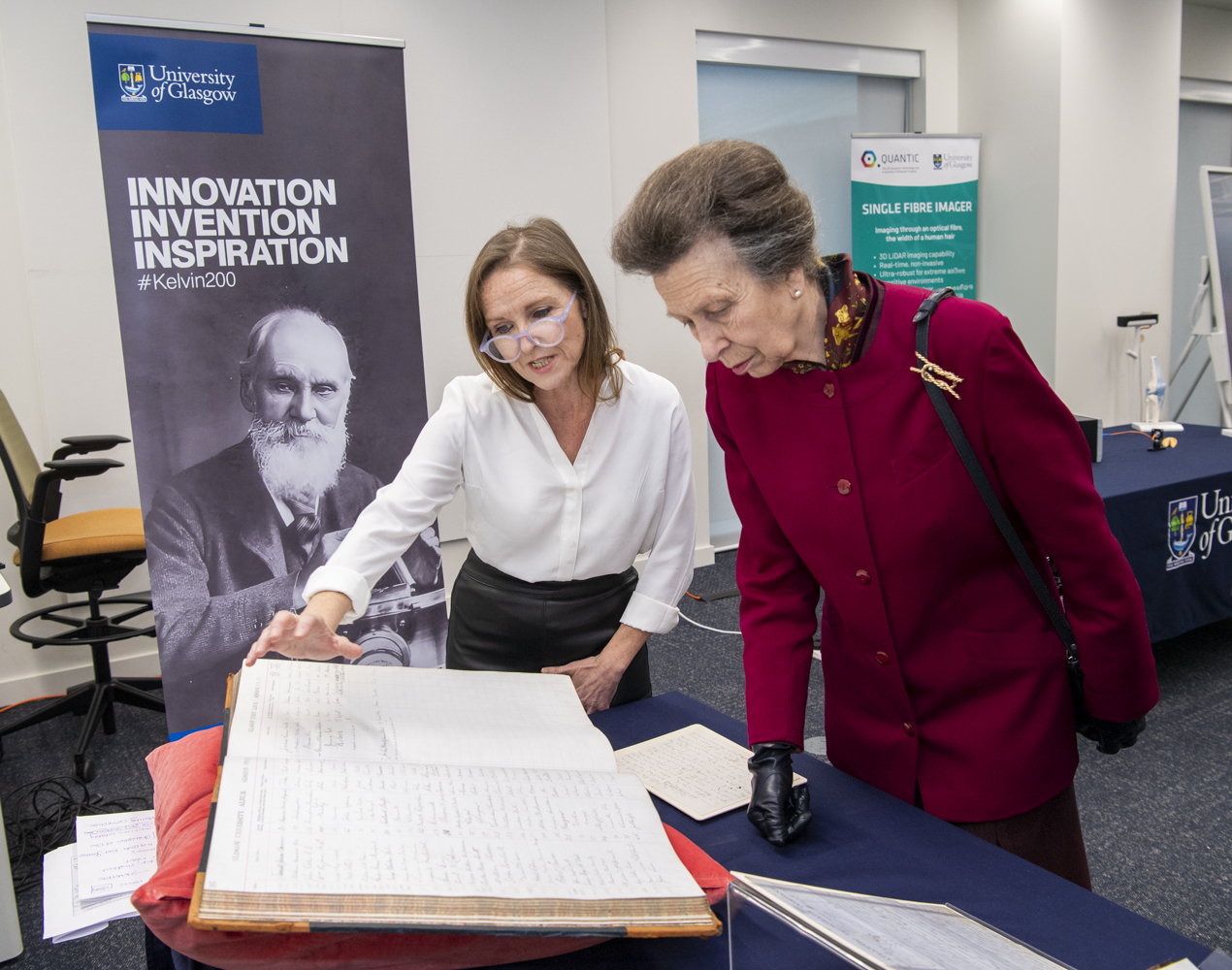University of Glasgow hosts royal visit to celebrate Lord Kelvin bicentenary
Published: 13 November 2024
The University of Glasgow has welcomed Her Royal Highness The Princess Royal to campus to learn more about Lord Kelvin during the bicentennial year of his birth.
The University of Glasgow has welcomed Her Royal Highness The Princess Royal to campus to learn more about Lord Kelvin during the bicentennial year of his birth.
The Princess Royal visited the Mazumdar-Shaw Advanced Research Centre on Tuesday 12 November to hear about Kelvin’s life and work, and how ongoing research projects are continuing to build on his world-changing achievements.
As part of the visit, The Princess Royal unveiled a plaque to commemorate the occasion and the 200th anniversary of the birth of Lord Kelvin. The plaque will go on permanent display on the University campus.

John MacLeod from Glasgow City Council hosted the visit in his role as Deputy Lord Lieutenant, one of the King’s representatives in the city.
Born William Thomson in Belfast in 1824, Kelvin first made a name for himself as the University’s youngest-ever student, matriculating at age 10. At age 22, he took up the post of Chair of Natural Philosophy at the University, which he held for 53 years.
During his tenure in the role, he made a series of pioneering developments in physics, engineering and mathematics, including the development of the first transatlantic telegraph cable and the absolute scale of temperature now better known as the Kelvin scale.
His work earned him a peerage in 1892, and he chose the title Baron Kelvin of Largs inspired by the river that flows through the city and the coastal town where he kept a home.
Professor Sir Anton Muscatelli, Principal and Vice-Chancellor of the University of Glasgow, welcomed The Princess Royal to campus. He said: “We were honoured to welcome The Princess Royal to the ARC today as part of our celebrations of the bicentenary of the birth of Lord Kelvin.
“Kelvin’s wide-ranging achievements helped shape the modern world, and continue to inspire work across the University today. Our researchers are working on groundbreaking projects in next-generation communications, imaging, precision measurement and more. We were delighted to have the opportunity to showcase some of that research for The Princess Royal, and to have her unveil a plaque to commemorate the occasion.”
During the visit, The Princess Royal took a tour of the ARC’s cutting-edge Extended Reality (XR) Lab for a demonstration of the Museums in the Metaverse project. The project uses virtual and extended reality technology to connect people worldwide with virtual versions of museum artifacts.
The legacy of Lord Kelvin was showcased with examples of current-day research which reflect different aspects of his enduring influence.
Professor Miles Padgett, the University’s Kelvin Chair of Natural Philosophy, demonstrated a new type of endoscope thinner than a human hair which enables 3D imaging through cutting-edge quantum technologies.

Professor Marian Scott, winner of the 2024 Lord Kelvin Royal Society of Edinburgh Medal, discussed her work and the University's commitment to STEM education, building on Kelvin’s legacy as an educator.
Professor Chris Pearce and colleagues highlighted how Kelvin's work has helped inspire next-generation telecommunications and sustainability projects at the James Watt School of Engineering, and how the University is working to help the UK achieve its net-zero goals.
Deputy Vice Chancellor (External Engagement) Professor Rachel Sandison and Pablo Morán Ruiz, President of the Students’ Representative Council, discussed how Kelvin's global recognition has helped to shape Glasgow's reputation as a world-leading institution, and how the University is building on its civic agenda as one of the city’s key institutions.

The Princess Royal also had the opportunity to hear about Kelvin’s achievements, and view some of the historic Kelvin-related items preserved by the University’s archive services team. They included Kelvin’s first matriculation record, handwritten notes and correspondence, and a copy of the 1858 telegram sent by American president James Buchanan to Queen Victoria – one of the first messages ever transmitted by the translatlantic telegraph cable.
The visit concluded with remarks from the Principal about the bicentenary of Lord Kelvin and reflections on the continued importance of British science and pioneers like Lord Kelvin in shaping the nation.
First published: 13 November 2024

